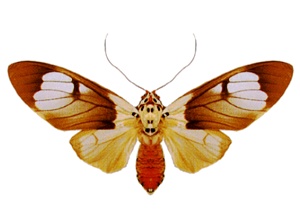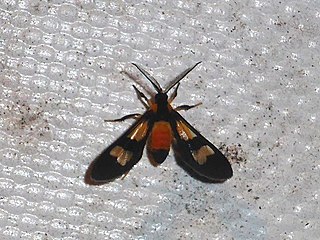
Amerila is a genus of moths in the subfamily Arctiinae.

Asura is a genus of moths in the subfamily Arctiinae, and subtribe Nudariina erected by Francis Walker in 1854.

Cisthene is a genus of lichen moths in the family Erebidae. The genus was erected by Francis Walker in 1854.
Cyme is a genus of moths in the family Erebidae. The genus was described by Felder in 1861.

Hemonia is a genus of moths in the family Erebidae first described by Francis Walker in 1863. They are found only in Sri Lanka and Borneo.

Leucotmemis is a genus of moths in the subfamily Arctiinae. The genus was erected by Arthur Gardiner Butler in 1876.
Pheia is a genus of moths in the subfamily Arctiinae erected by Francis Walker in 1854.

Schistophleps is a genus of moths in the family Erebidae first described by George Hampson in 1891.

Psara is a genus of moths in the family Crambidae described by Snellen in 1875.

Bastilla is a genus of moths in the family Erebidae. The genus was described by Charles Swinhoe in 1918.
Amerila simillima is a moth of the subfamily Arctiinae. It was described by Walter Rothschild in 1917. It is found in Australia.
Damias simillima is a moth of the family Erebidae first described by Walter Rothschild in 1936. It is found in New Guinea.
Hemonia murina is a moth of the family Erebidae. It was described by Walter Rothschild in 1913. It is found on New Guinea.
Hemonia schistacea is a moth of the family Erebidae. It was described by Walter Rothschild in 1913. It is found in Papua New Guinea.
Hemonia schistaceoalba is a moth of the family Erebidae. It was described by Walter Rothschild in 1913. It is found in New Guinea.
Pheia simillima is a moth in the subfamily Arctiinae. It was described by Rothschild in 1931. It is found in Colombia.
Schistophleps simillima is a moth in the subfamily Arctiinae. It was described by Rothschild in 1913. It is found in New Guinea.
Acrojana is a genus of moths in the family Eupterotidae.
Acrojana simillima is a moth in the family Eupterotidae. It was described by Rothschild in 1932. It is found in Sierra Leone.







